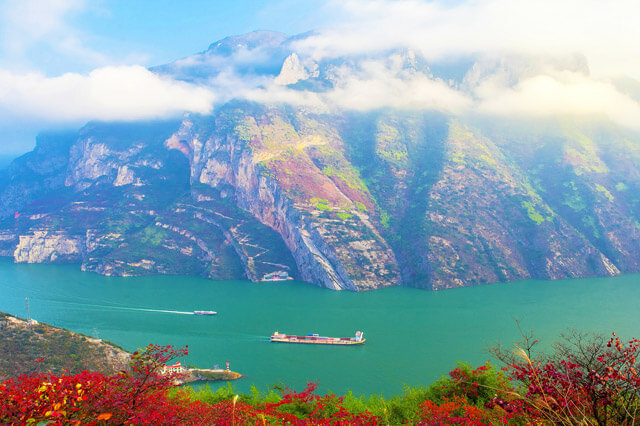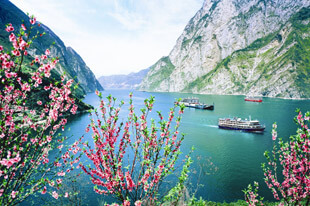
The longest river in Asia holds great historical, economical and cultural importance to the country. It accommodates the controversial Three Gorges Dam which is the largest hydro-electric power station in the world. It also thought by many to divide Northern and Southern China; both areas are immensely different in terms of climate, culture, economics, folk customs and landscape. Along the river there are many areas of historical interest, as well as much natural beauty. Because of its vast size, one of the most relaxing ways to enjoy the river is by taking a cruise or a tour of the area. Independent Asia specialists Exotissimo offers a cruise which includes stops at the mysterious Fengdu Ghost City and the precious stone fortress, Shibaozhai.
Yangtze River, world’s 3rd longest river, is not only a winner of its length. However, floating across from the western region to east edge of China, this mother river for Chinese people presents one of the superb natural splendors for tourists from the whole globe. Worldwide well-known, taking a Yangtze River cruise ship is the best and most relaxing way to savor the elegant charm of the Yangtze, take in the gorgeous image of the magnificent Three Gorges, and enjoy the utmost fun of top classic attractions along the water.
Before your wonderful and long expecting Yangtze River cruise in 2020, we here collect the real photos of the Yangtze River itself and those shore excursion sites and classify them into different photo albums by places, just to offer you a warm-up. Browse at below to get a prior great catch of the highlights of Yangtze River cruise!

Shore Excursion Sites
You will not always spend your leisure time onboard the ship. Walk to the land and pay fresh visits to the famous classic scenic spots to bath with the landscape of the Three Gorges, Shennv and Shennong streams, learn the history and culture at Fengdu Ghost City, White Emperor City, etc., know the folk life at the primitive Tribe of the Three Gorges… Enjoy the photo galleries of Yangtze River shore excursion sites at will at below!
Yangtze River, Chinese (Pinyin) Chang Jiang or (Wade-Giles romanization) Ch’ang Chiang, longest river in both China and Asia and third longest river in the world, with a length of 3,915 miles (6,300 kilometres). Its basin, extending for some 2,000 miles (3,200 km) from west to east and for more than 600 miles (1,000 km) from north to south, drains an area of 698,265 square miles (1,808,500 square km). From its source on the Plateau of Tibet to its mouth on the East China Sea, the river traverses or serves as the border between 10 provinces or regions. More than three-fourths of the river’s course runs through mountains. The Yangtze has eight principal tributaries. On its left bank, from source to mouth, these are the Yalung, Min, Jialing, and Han rivers; those on the right bank include the Jiang or (Wade-Giles romanization) Ch’ang Chiang,.

longest river in both China and Asia and third longest river in the world, with a length of 3,915 miles (6,300 kilometres). Its basin, extending for some 2,000 miles (3,200 km) from west to east and for more than 600 miles (1,000 km) from north to south, drains an area of 698,265 square miles (1,808,500 square km). From its source on the Plateau of Tibet to its mouth on the East China Sea, the river traverses or serves as the border between 10 provinces or regions. More than three-fourths of the river’s course runs through mountains. The Yangtze has eight principal tributaries. On its left bank, from source to mouth, these are the Yalung, Min, Jialing, and Han rivers; those on the right bank include the Wu, Yuan, Xiang, and Gan rivers.


The Huang He basin and the Yangtze River basin and their drainage networks.Encyclopædia Britannica, Inc.
Bend in the upper Yangtze River (Chang Jiang), Yunnan province, southwestern China.© itasun/iStock.com
The name Yangtze—derived from the name of the ancient fiefdom of Yang—has been applied to the river mainly by those in the West. Chang Jiang (“Long River”) is the name used in China, although it also is called Da Jiang (“Great River”) or, simply, Jiang (“[The] River”). The Yangtze is the most important river of China. It is the country’s principal waterway, and its basin is China’s great granary and contains nearly one-third of the national population.

Comments
Post a Comment